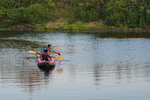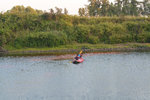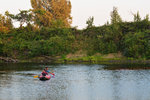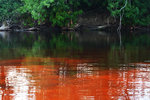



As dusk fell Monday evening, a pair of government officials quietly slipped a boat into the Chehalis River and began pouring a chemical compound into the water, sending plumes of bright red stretching to the bank.
Despite the shady scene, this wasn’t a nefarious operation. The officials were Department of Ecology scientists using a harmless, non-toxic dye to test how quickly the river’s water travels to various points. That data will help inform ongoing work in the Chehalis Basin, which has been the focus of concerted efforts at the state and local levels to reduce flooding and restore aquatic habitat.
“Every time you do something that builds on the knowledge base, it's going to help us as we look at this long-term planning. You've got to have this type of data,” said Curt Hart, the Department of Ecology’s communications manager. “It could provide information for future permitting, it could provide information for what would make sense if we were going do a restoration project. Flood damage — what are the flows looking like?”
The Monday test at Fort Borst Park was part of four different sites where scientists are testing the flow this week. The other sites include Lintott/Alexander Park in Chehalis, the State Route 6 crossing of the Chehalis River at Pe Ell and the canyon between Ceres Hill and Adna.
Water quality scientists Nuri Mathieu and Sheelagh McCarthy paddled an inflatable kayak out into the placid river, where Mathieu dumped about two liters of Rhodamine dye into the water. The dye spread into red clouds and gradually moved toward the far bank, already giving hints of the river’s invisible current.
“It all moved over to that left bank,” Hart said. “You get a good visual here.”
After placing the dye at each site, the Ecology team will move downstream to test how long it takes to travel various distances down the river. Though the dye becomes invisible to the human eye by the time it goes about a mile downstream, fluorometers can detect its presence at much further distances. The Rhodamine has no ill effects for the habitat, but the scientists scheduled the tests for the evening to avoid disturbing river activities.
According to Mathieu, the river’s flow can provide hints at a number of factors that affect aquatic health, such as temperature and dissolved oxygen content. It’s easier to determine that flow rate during wet seasons, when flow gages track the pace of high-water events. But it’s important to have similar models for the summer months as well, which is where the dye comes in.
“That's a really important piece when we're trying to have our water quality models accurately represent how the system is reacting,” he said. “How quickly pollutants disperse; if a colder tributary is coming into the Chehalis, how quickly does that mix? If you had an upset at a wastewater treatment plant and you wanted to see what would happen with the concentrations over time, it's useful for that.”
Areas of slower flow, Hart said, generally correlate to higher temperatures, readings the scientists will also be taking. Those higher temperatures can cause algae to bloom and cause conditions that reduce the dissolved oxygen content in the water, making it an inhospitable habitat.
Targeting areas where that might be the case could help inform work done under the Aquatic Species Restoration Plan. The work done under the Chehalis Basin Strategy is two-pronged, addressing both flood mitigation and river habitat, known as the ASRP.
Essentially, the information collected in the dye testing could become part of the roadmap for any number of potential projects on the Chehalis.
“We're gathering more information and really fine tuning what we know about certain points of the river at certain times of the year,” Hart said. “It sets up how we would look at how do we do water quality or water cleanup plans in that stretch of the river. ... What are those problems? That's the important thing of having the water quality models really calibrated and assessed.”
Mathieu, who last did dye testing on the Pilchuck River in 2016, said the dye generally takes a few hours to travel a mile downstream.
“That varies a lot on the Chehalis River,” he added.
The segments the Ecology scientists are testing range from 20 miles to seven or eight miles. The longer stretches will have multiple testing points between the spots where the dye is released.
“The more we can slice that up, the better the information,” Mathieu said.